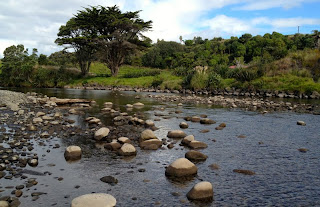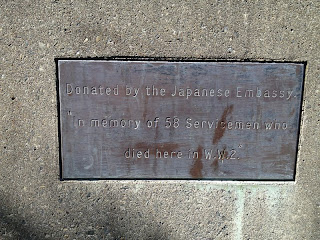Tucked up in our pleasant little spot we settled in to quietly watch some TV - Yeah Right.
The NZ Fire Service arrived , it was a training exercise.
The only building here was the football club and they were hell bent on saving it from burning down.
No hydrants here , so out with the portable pump, mind the hose.
The tide was out so there was some 50m of sand and stone to stumble over.
And stumble they did.

Sections of floating hose were connected together.
They were attached to a floating filtration device and carefully positioned in the deepest part of the estuary.
Then it was all hands to the pump , as the saying goes.
With a "cough , cough , go" the pump roared into life and the red "roll up" hose snaked its way towards the Fire Engine.
Then there was water everywhere , the hose had come off the storage tank.
Quickly reattached, the tank was filling fast.
The Fire Engine has a high pressure pump on board which boosts the pressure so the hoses become effective.
All this action does not happen by its self.
For every one actually doing something there was 2 or 3 "observers".
But it was a training exercise.
There had to be "the trainers" and guys with clip boards who seemed to "marking" the trainee's.
Then there was the Traffic Control guys.
After all there was 4 motorhomes in the action zone (all parked).
Then there was the Crowd Control guys who had to keep the onlookers (me) clear of the danger zone.
We had a good chat which lulled him into a false sense of security , so every time he looked away I would duck around the other side of the rig to take some more photos.
Kept him on his toes.
Finally it all kicked in and 2 hoses were operating.
The first hose had a nozzle which produced a fine conical shaped spray which was adjustable.
The photo shows it at its maximum reach.
It could be wound back to make a circle of spray just in front of the firefighters.
Necessary if they have to enter burning buildings.
The other hose had a long reach flow of water.
Both hoses needed 2 people to control them , such was the force of the high pressure water.
Extra "assisted breathing" devices were on hand.
Happily they were not needed this time.
Apparently a third unit was supposed to be at this practice.
The clubrooms was a full two storey structure.
In a actual fire an "aerial unit" would be deployed.
 That is one of those rigs with a long extendable ladder that takes a hose and a fireman up high enough to fight a fire in the roof.
That is one of those rigs with a long extendable ladder that takes a hose and a fireman up high enough to fight a fire in the roof.Despite all the cellphone calls and conversations
the "aerial unit" that is based in New Plymouth was on duty at an actual fire.
 Damn it - its attendance would have sparkled things up a bit.
Damn it - its attendance would have sparkled things up a bit.Practice is over , everything is packed away.
A debriefing was held .
All the guys standing around the back of our ute.
Two of the big, burly ones relaxed a bit by resting onto the ute.
Bingo - the alarm was triggered.
Red faces and lots of laughter.
Where would we be without them?























































